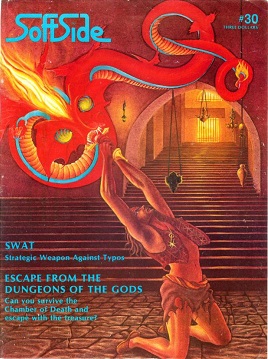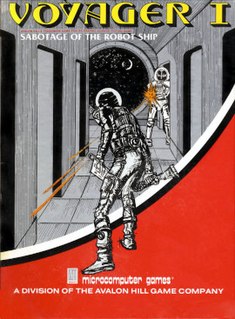
The TRS-80 Micro Computer System is a desktop microcomputer launched in 1977 and sold by Tandy Corporation through their Radio Shack stores. The name is an abbreviation of Tandy Radio Shack, Z80 [microprocessor]. It is one of the earliest mass-produced and mass-marketed retail home computers.

The MCS-48 microcontroller series, Intel's first microcontroller, was originally released in 1976. Its first members were 8048, 8035 and 8748. The 8048 is probably the most prominent member of the family. Initially, this family was produced using NMOS technology. In the early 1980s, it became available in CMOS technology. It was still manufactured into the 1990s to support older designs that still used it.

SoftSide is a defunct computer magazine, begun in October 1978 by Roger Robitaille and published by SoftSide Publications of Milford, New Hampshire.

FS1 Flight Simulator is a 1979 video game published by Sublogic for the Apple II. A TRS-80 version followed in 1980. FS1 Flight Simulator is a flight simulator in the cockpit of a slightly modernized Sopwith Camel. FS1 is the first in a line of simulations from Sublogic which, beginning in 1982, were also sold by Microsoft as Microsoft Flight Simulator.

Airmail Pilot is a video game published in 1979 by Instant Software, in which the player pilots a Curtiss JN-4D "Jenny" biplane departing from Columbus, Ohio, loaded with mail for Chicago.

Star Trek III.4 is a 1979 video game designed by Lance Micklus and published by The Software Exchange for the TRS-80.
Money Madness is a 1980 video game published by Instant Software for the TRS-80.
Who-Dun-It? is a 1979 video game published by Instant Software for the TRS-80 16K. It is named for the whodunit, a type of crime fiction.

Robot Attack is a clone of the arcade game Berzerk written by Bill Hogue and Jeff Konyu for the TRS-80 and published by Big Five Software in 1981. It was the first game from Big Five to include speech.
Instant Software was a company that produced game, utility, and education software in the late 1970s and early 1980s primarily for the TRS-80 line of home computers. Instant Software was a subsidiary of Kilobaud Microcomputing, headquartered in Peterborough, New Hampshire and run by Wayne Green.
The Software Exchange was a company that produced computer games in the late 1970s and early 1980s, primarily for the TRS-80. It has origins with SoftSide magazine.

The Eliminator is a video game written by Terry Gilman and Wayne Westmoreland for the TRS-80 and published by Adventure International in 1981. It was ported to the Atari 8-bit family and Apple II. The Eliminator is a clone of the Defender arcade game.

Galaxy is a 1981 video game published by Avalon Hill and developed by Microcomputer Games for the Apple II, TRS-80, Atari 8-bit family, Commodore PET, Commodore 64, IBM PC compatibles, FM-7, and TI-99/4A. It was originally published as Galactic Empires by Powersoft in 1979.

Windsloe Mansion is a text adventure published by Adventure of the Month Club for the Apple II, Atari 8-bit family, and TRS-80. It was the January 1982 Adventure of the Month.

Reign of the Red Dragon is video game written by Dave Daring for the TRS-80 and published by Adventure International in 1982.

Voyager I: Sabotage of the Robot Ship is a computer game designed and programmed by William D. Volk, and published by the Microcomputer Games division of Avalon Hill. It was originally released for the Apple II in 1981, with later versions for the Atari 8-bit family, TRS-80 Color Computer, TRS-80, and Commodore PET.

Mad Mines is a fixed shooter video game written for the TRS-80 by Yves Lempereur and published by Funsoft in 1982.

The Sands of Egypt is a 1982 graphic adventure game written by James Garon, Ralph Burris, and Steve Bjork of Datasoft for the TRS-80 Color Computer. It was licensed to Tandy Corporation and was the first disk-only game for the Color Computer sold by RadioShack. Ports to the Atari 8-bit family in 1982 and Apple II in 1983 were published by Datasoft. Set in 1893, the game follows a British explorer and archaeologist who is lost in the desert. Text commands are entered in the lower half of the screen, while a sometimes animated image of the current location is displayed in the upper half.














